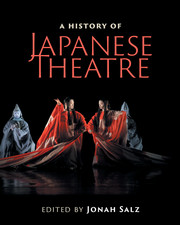Book contents
- Frontmatter
- Contents
- List of figures
- List of tables
- Contributors
- Contributors’ biographies
- Foreword
- Acknowledgments
- Note on Japanese terms
- List of abbreviations
- Timeline
- Editor's introduction
- I Traditional theatres
- Preface to Part I Japanese civilization arises
- II Modern theatres
- Preface to Part II
- III Arcs and patterns
- IV Theatre architecture
- Preface to Part IV Evolution of Japanese theatre architecture
- V Theatre criticism
- VI Intercultural influences
- Epilogue: Frozen words and mythology
- Further reading
- Index
Timeline
Published online by Cambridge University Press: 05 July 2016
- Frontmatter
- Contents
- List of figures
- List of tables
- Contributors
- Contributors’ biographies
- Foreword
- Acknowledgments
- Note on Japanese terms
- List of abbreviations
- Timeline
- Editor's introduction
- I Traditional theatres
- Preface to Part I Japanese civilization arises
- II Modern theatres
- Preface to Part II
- III Arcs and patterns
- IV Theatre architecture
- Preface to Part IV Evolution of Japanese theatre architecture
- V Theatre criticism
- VI Intercultural influences
- Epilogue: Frozen words and mythology
- Further reading
- Index
Summary
This Timeline is an attempt to show linearly the convoluted, inter-related trajectories of Japanese traditional arts through time. Some caveats concerning Japanese traditional arts deserve mentioning.
New genres evolve from older ones, but rarely is the older form completely abandoned. Instead, new genres distinguish themselves from previous ones often by borrowing from, or absorbing, a number of prior styles of music, song, costume, dance, or text, in an innovative manner. Establishing a popular new genre does not necessarily mean the diminishment of older forms. They may, in fact, benefit from a surge in popularity from new attention that newer genres focus on them.
Traditions, even after rigid codification, have expanded their repertoire by incorporating new pieces or accompanying music; expanded their audiences by performing at new venues or touring to new regions; or expanded their performers by admitting females into previously all-male traditions. Contrarily, some have condensed to narrow specialties when forced to compete with new genres or schools for ensuring niche market share. Shogunal restrictions on repertoire also resulted in much rationalization and reduction. Yet traditional performance in Japan is a braided strand of rope that rarely breaks despite the twists and frays that occasionally occur. In lean times, some genres are maintained by just a single family (or person) until their popularity revives, bolstered by branch families or even amateurs who broaden the art through their idiosyncratic variant interpretations.
Inevitably the Timeline's description of creative development may seem to some as mere competent continuation. A wave of new pieces and popularity may not necessarily demonstrate development: it could be a desperate attempt to regain popularity before fading from the scene. On the other hand, brilliant actors breathe new life into stale repertoire; even a few extant troupes can bring legions of fans to minor genres. While eliding such exceptions, the following schematic may provide some sense of the transmission and transformation trajectories of Japanese traditional dance and theatre through time, and the rich feast available to contemporary audiences of any time period.
- Type
- Chapter
- Information
- A History of Japanese Theatre , pp. xxxii - xxxiiiPublisher: Cambridge University PressPrint publication year: 2016

